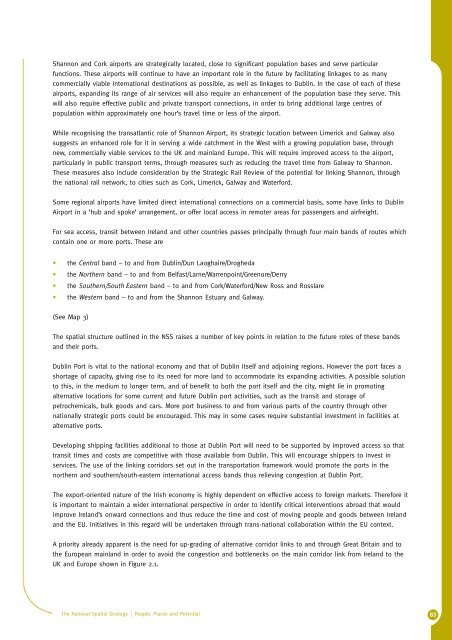National Spatial Strategy For Ireland 2002 - 2020 - Full ... - Kildare.ie
National Spatial Strategy For Ireland 2002 - 2020 - Full ... - Kildare.ie
National Spatial Strategy For Ireland 2002 - 2020 - Full ... - Kildare.ie
You also want an ePaper? Increase the reach of your titles
YUMPU automatically turns print PDFs into web optimized ePapers that Google loves.
Shannon and Cork airports are strategically located, close to significant population bases and serve particular<br />
functions. These airports will continue to have an important role in the future by facilitating linkages to as many<br />
commercially viable international destinations as possible, as well as linkages to Dublin. In the case of each of these<br />
airports, expanding its range of air services will also require an enhancement of the population base they serve. This<br />
will also require effective public and private transport connections, in order to bring additional large centres of<br />
population within approximately one hour’s travel time or less of the airport.<br />
While recognising the transatlantic role of Shannon Airport, its strategic location between Limerick and Galway also<br />
suggests an enhanced role for it in serving a wide catchment in the West with a growing population base, through<br />
new, commercially viable services to the UK and mainland Europe. This will require improved access to the airport,<br />
particularly in public transport terms, through measures such as reducing the travel time from Galway to Shannon.<br />
These measures also include consideration by the Strategic Rail Rev<strong>ie</strong>w of the potential for linking Shannon, through<br />
the national rail network, to cit<strong>ie</strong>s such as Cork, Limerick, Galway and Waterford.<br />
Some regional airports have limited direct international connections on a commercial basis, some have links to Dublin<br />
Airport in a ‘hub and spoke’ arrangement, or offer local access in remoter areas for passengers and airfreight.<br />
<strong>For</strong> sea access, transit between <strong>Ireland</strong> and other countr<strong>ie</strong>s passes principally through four main bands of routes which<br />
contain one or more ports. These are<br />
• the Central band – to and from Dublin/Dun Laoghaire/Drogheda<br />
• the Northern band – to and from Belfast/Larne/Warrenpoint/Greenore/Derry<br />
• the Southern/South Eastern band – to and from Cork/Waterford/New Ross and Rosslare<br />
• the Western band – to and from the Shannon Estuary and Galway.<br />
(See Map 3)<br />
The spatial structure outlined in the NSS raises a number of key points in relation to the future roles of these bands<br />
and their ports.<br />
Dublin Port is vital to the national economy and that of Dublin itself and adjoining regions. However the port faces a<br />
shortage of capacity, giving rise to its need for more land to accommodate its expanding activit<strong>ie</strong>s. A possible solution<br />
to this, in the medium to longer term, and of benefit to both the port itself and the city, might l<strong>ie</strong> in promoting<br />
alternative locations for some current and future Dublin port activit<strong>ie</strong>s, such as the transit and storage of<br />
petrochemicals, bulk goods and cars. More port business to and from various parts of the country through other<br />
nationally strategic ports could be encouraged. This may in some cases require substantial investment in facilit<strong>ie</strong>s at<br />
alternative ports.<br />
Developing shipping facilit<strong>ie</strong>s additional to those at Dublin Port will need to be supported by improved access so that<br />
transit times and costs are competitive with those available from Dublin. This will encourage shippers to invest in<br />
services. The use of the linking corridors set out in the transportation framework would promote the ports in the<br />
northern and southern/south-eastern international access bands thus rel<strong>ie</strong>ving congestion at Dublin Port.<br />
The export-or<strong>ie</strong>nted nature of the Irish economy is highly dependent on effective access to foreign markets. Therefore it<br />
is important to maintain a wider international perspective in order to identify critical interventions abroad that would<br />
improve <strong>Ireland</strong>’s onward connections and thus reduce the time and cost of moving people and goods between <strong>Ireland</strong><br />
and the EU. Initiatives in this regard will be undertaken through trans-national collaboration within the EU context.<br />
A priority already apparent is the need for up-grading of alternative corridor links to and through Great Britain and to<br />
the European mainland in order to avoid the congestion and bottlenecks on the main corridor link from <strong>Ireland</strong> to the<br />
UK and Europe shown in Figure 2.1.<br />
The <strong>National</strong> <strong>Spatial</strong> <strong>Strategy</strong> | People, Places and Potential<br />
63
















